1. Mayumi T, Takada T, Kawarada Y, Nimura Y, Yoshida M, Sekimoto M, et al. Results of the Tokyo Consensus Meeting Tokyo Guidelines. J Hepatobiliary Pancreat Surg. 2007; 14:114–121. PMID:
17252304.

2. Okamoto K, Suzuki K, Takada T, Strasberg SM, Asbun HJ, Endo I, et al. Tokyo Guidelines 2018: flowchart for the management of acute cholecystitis. J Hepatobiliary Pancreat Sci. 2018; 25:55–72. PMID:
29045062.
3. Gutt CN, Encke J, Köninger J, Harnoss JC, Weigand K, Kipfmüller K, et al. Acute cholecystitis: early versus delayed cholecystectomy, a multicenter randomized trial (ACDC study, NCT00447304). Ann Surg. 2013; 258:385–393. PMID:
24022431.
4. Macafee DA, Humes DJ, Bouliotis G, Beckingham IJ, Whynes DK, Lobo DN. Prospective randomized trial using cost-utility analysis of early versus delayed laparoscopic cholecystectomy for acute gallbladder disease. Br J Surg. 2009; 96:1031–1040. PMID:
19672930.

5. Wani H, Meher S, Srinivasulu U, Mohanty LN, Modi M, Ibrarullah M. Laparoscopic cholecystectomy for acute cholecystitis: any time is a good time. Ann Hepatobiliary Pancreat Surg. 2023; 27:271–276. PMID:
37088998.

6. Endo I, Takada T, Hwang TL, Akazawa K, Mori R, Miura F, et al. Optimal treatment strategy for acute cholecystitis based on predictive factors: Japan-Taiwan multicenter cohort study. J Hepatobiliary Pancreat Sci. 2017; 24:346–361. PMID:
28419741.

7. Sugiyama M, Tokuhara M, Atomi Y. Is percutaneous cholecystostomy the optimal treatment for acute cholecystitis in the very elderly? World J Surg. 1998; 22:459–463. PMID:
9564288.

8. Mori Y, Itoi T, Baron TH, Takada T, Strasberg SM, Pitt HA, et al. Tokyo Guidelines 2018: management strategies for gallbladder drainage in patients with acute cholecystitis (with videos). J Hepatobiliary Pancreat Sci. 2018; 25:87–95. PMID:
28888080.
9. Hibi T, Iwashita Y, Ohyama T, Honda G, Yoshida M, Takada T, et al. The “right” way is not always popular: comparison of surgeons’ perceptions during laparoscopic cholecystectomy for acute cholecystitis among experts from Japan, Korea and Taiwan. J Hepatobiliary Pancreat Sci. 2017; 24:24–32. PMID:
28026137.

10. Rice CP, Vaishnavi KB, Chao C, Jupiter D, Schaeffer AB, Jenson WR, et al. Operative complications and economic outcomes of cholecystectomy for acute cholecystitis. World J Gastroenterol. 2019; 25:6916–6927. PMID:
31908395.

11. Komatsu S, Tsuchida S, Tsukamoto T, Wakahara T, Ashitani H, Ueno N, et al. Current role of percutaneous transhepatic gallbladder aspiration: from palliative to curative management for acute cholecystitis. J Hepatobiliary Pancreat Sci. 2016; 23:708–714. PMID:
27580211.

12. Austin PC. An introduction to propensity score methods for reducing the effects of confounding in observational studies. Multivariate Behav Res. 2011; 46:399–424. PMID:
21818162.

13. Singer M, Deutschman CS, Seymour CW, Shankar-Hari M, Annane D, Bauer M, et al. The Third International Consensus Definitions for Sepsis and Septic Shock (Sepsis-3). JAMA. 2016; 315:801–810. PMID:
26903338.

14. Strasberg SM, Hertl M, Soper NJ. An analysis of the problem of biliary injury during laparoscopic cholecystectomy. J Am Coll Surg. 1995; 180:101–125. PMID:
8000648.
15. Nassar A, Elshahat I, Forsyth K, Shaikh S, Ghazanfar M. Outcome of early cholecystectomy compared to percutaneous drainage of gallbladder and delayed cholecystectomy for patients with acute cholecystitis: systematic review and meta-analysis. HPB (Oxford). 2022; 24:1622–1633. PMID:
35597717.

16. Yamazaki S, Shimizu A, Kubota K, Notake T, Yoshizawa T, Masuo H, et al. Urgent versus elective laparoscopic cholecystectomy following percutaneous transhepatic gallbladder drainage for high-risk grade II acute cholecystitis. Asian J Surg. 2023; 46:431–437. PMID:
35610148.

17. Jia B, Liu K, Tan L, Jin Z, Liu Y. Percutaneous transhepatic gallbladder drainage combined with laparoscopic cholecystectomy versus emergency laparoscopic cholecystectomy in acute complicated cholecystitis: comparison of curative efficacy. Am Surg. 2018; 84:438–442. PMID:
29559062.

18. Lee SJ, Choi IS, Moon JI, Yoon DS, Lee SE, Sung NS, et al. Elective laparoscopic cholecystectomy is better than conservative treatment in elderly patients with acute cholecystitis after percutaneous transhepatic gallbladder drainage. J Gastrointest Surg. 2021; 25:3170–3177. PMID:
34173163.

19. Jung BH, Park JI. Impact of scheduled laparoscopic cholecystectomy in patients with acute cholecystitis, following percutaneous transhepatic gallbladder drainage. Ann Hepatobiliary Pancreat Surg. 2017; 21:21–29. PMID:
28317042.

20. Tan HY, Jiang DD, Li J, He K, Yang K. Percutaneous transhepatic gallbladder drainage combined with laparoscopic cholecystectomy: a meta-analysis of randomized controlled trials. J Laparoendosc Adv Surg Tech A. 2018; 28:248–255. PMID:
29265953.

21. Lyu Y, Li T, Wang B, Cheng Y. Early laparoscopic cholecystectomy after percutaneous transhepatic gallbladder drainage for acute cholecystitis. Sci Rep. 2021; 11:2516. PMID:
33510242.

22. Sakamoto T, Fujiogi M, Matsui H, Fushimi K, Yasunaga H. Timing of cholecystectomy after percutaneous transhepatic gallbladder drainage for acute cholecystitis: a nationwide inpatient database study. HPB (Oxford). 2020; 22:920–926. PMID:
31732466.

23. Inoue K, Ueno T, Nishina O, Douchi D, Shima K, Goto S, et al. Optimaltiming of cholecystectomy after percutaneous gallbladder drainage for severe cholecystitis. BMC Gastroenterol. 2017; 17:71. PMID:
28569137.

24. Kimura K, Adachi E, Omori S, Toyohara A, Higashi T, Ohgaki K, et al. The influence of the interval between percutaneous transhepatic gallbladder drainage and cholecystectomy on perioperative outcomes: a retrospective study. BMC Gastroenterol. 2021; 21:226. PMID:
34011273.

25. Lee JS, Lee SJ, Choi IS, Moon JI. Optimal timing of percutaneous transhepatic gallbladder drainage and subsequent laparoscopic cholecystectomy according to the severity of acute cholecystitis. Ann Hepatobiliary Pancreat Surg. 2022; 26:159–167. PMID:
35082174.

26. Ie M, Katsura M, Kanda Y, Kato T, Sunagawa K, Mototake H. Laparoscopic subtotal cholecystectomy after percutaneous transhepatic gallbladder drainage for grade II or III acute cholecystitis. BMC Surg. 2021; 21:386. PMID:
34717615.

27. Matsumoto M, Abe K, Futagawa Y, Furukawa K, Haruki K, Onda S, et al. New scoring system for prediction of surgical difficulty during laparoscopic cholecystectomy after percutaneous transhepatic gallbladder drainage. Ann Gastroenterol Surg. 2021; 6:296–306. PMID:
35261956.

28. Nakamura Y, Kuwahara M, Ito K, Inagaki F, Mihara F, Takemura N, et al. Percutaneous transhepatic gallbladder intervention as a bridge to cholecystectomy: aspiration or drainage? World J Surg. 2023; 47:1721–1728. PMID:
37000200.

29. Yu B, Zhi X, Li Q, Xu B, Dong Z, Li T, et al. The efficacy and safety of preoperative cholangiography via percutaneous transhepatic gallbladder drainage (PTGBD) for difficult laparoscopic cholecystectomy (LC). Surg Endosc. 2022; 36:1355–1361. PMID:
34013391.

30. Fujinaga A, Iwashita Y, Tada K, Watanabe K, Kawasaki T, Masuda T, et al. Efficacy of releasing impacted gallstones after percutaneous transhepatic gallbladder drainage for acute cholecystitis and consideration of the surgical difficulty during laparoscopic cholecystectomy. J Hepatobiliary Pancreat Sci. 2021; 28:993–999. PMID:
33128850.

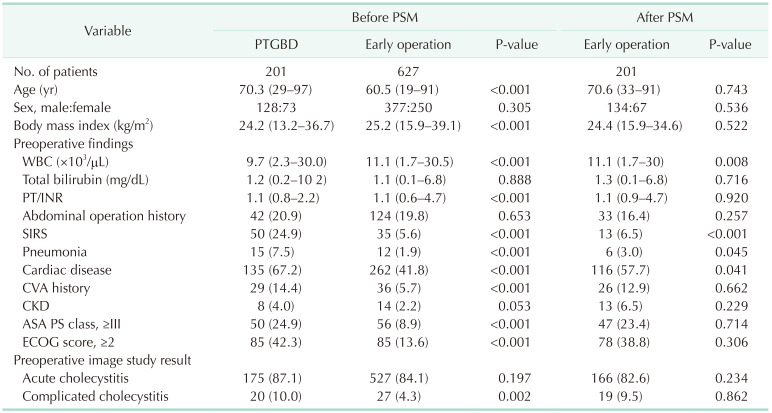
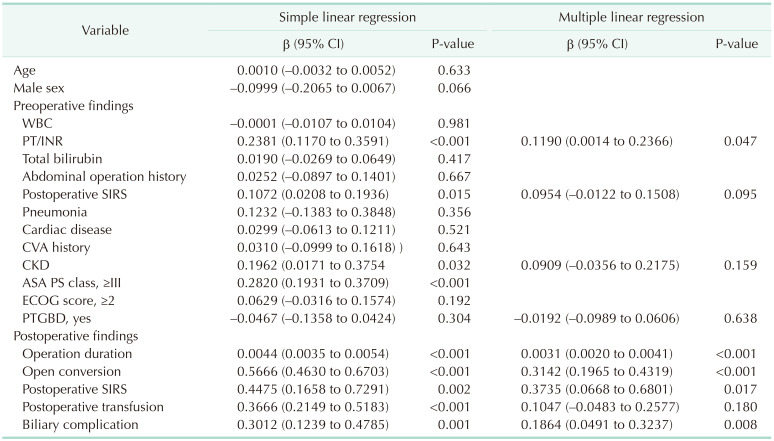
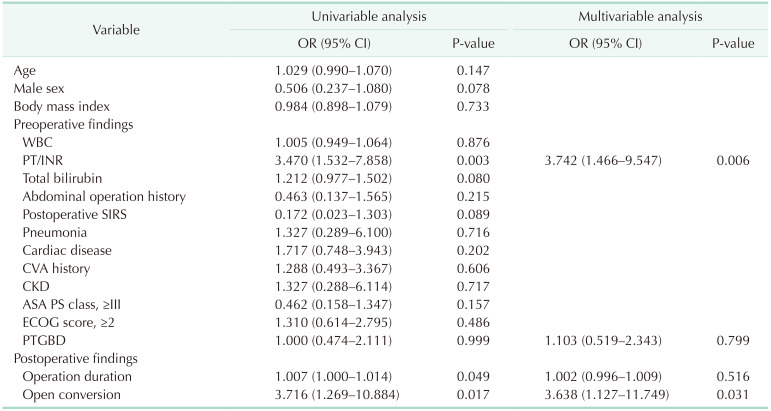




 PDF
PDF Citation
Citation Print
Print



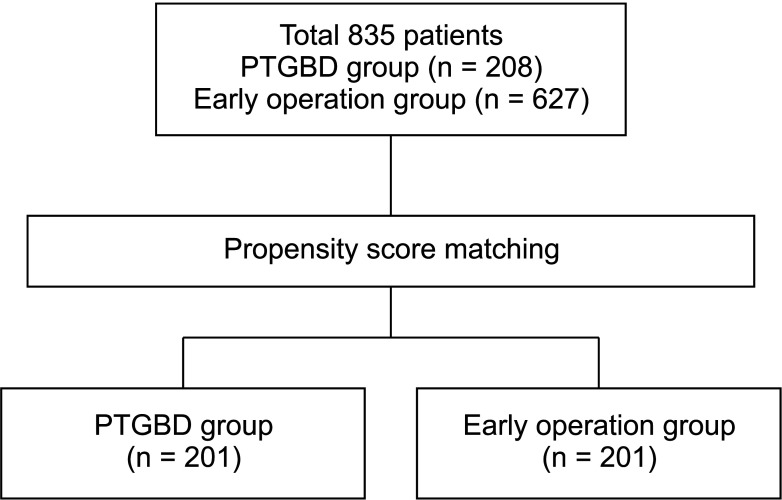
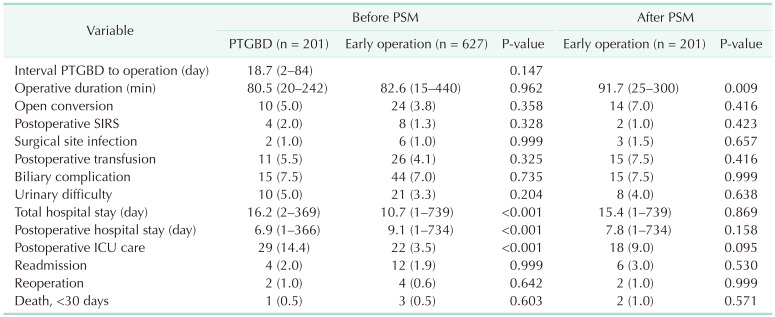
 XML Download
XML Download